Animal Science
Welcome to my blog. I will share my experiences and information regarding to my research, animal science, wildlife conservation effort especially in Malaysia and also on photography. Thank you for droping by, enjoy! :)
Friday, 22 March 2013
Monday, 9 May 2011
A trip to Gunung Gading National Park, Sarawak
 |
| Welcome to Gunung Gading National Park. Photo by: Hanifridzuan |
Do you plan to visit Kuching, Sarawak? If you are planning to do so, don’t miss the chance to visit one of the National Parks in Sarawak, Gunung Gading. It is situated in Lundu district; about one and half hour drive from Kuching town. The park also offers some accommodation for the visitors for an overnight stay.
 |
| Let's explore the nature trails! Photo by: Hanifridzuan |
 |
| The largest flower in the world. Photo by: Hanifridzuan |
Gunung Gading National Park is a home for the largest flower in the world, Rafflesia. If you are lucky enough, you will see the Rafflesia in bloom or you can check earlier with the park office. This park is a suitable place for nature lovers, jungle tracking and hiking to the peak of Gunung Gading (900 meters). There are also a few beautiful, cool clear waterfalls in the park, and waterfall 1, 3 and 7 are accessible for the visitor and suitable for leisurely picnics. Let the pictures do the talking.
 |
| Waterfall no. 1. Photo by: Hanifridzuan |
 |
| It takes about one hour to reach Waterfall no. 7. Photo by: Hanifridzuan |
Take note that there is no food stall or canteen inside the park. So, bring along your lunch pack or you can try local food at several restaurants at Lundu.
Sunday, 8 May 2011
Simple tutorial on how to construct phylogenetic tree (NJ and MP) in MEGA 4 software
This is a simple tutorial, step by step on how to use MEGA file to construct phylogenetic tree (NJ and MP) in MEGA 4 software. To follow these simple steps, you will need to have a ‘MEG file’. I will explain on how to analyse your sequence and how to convert the data into ‘MEG file’ later.
1. Launch the MEGA 4 software
2. Click at ‘click me to activate data file’ or you can click ‘file’ then ‘open data’, or press F5.
3. Choose a data file to analyse, then click ‘open’.
4. MEGA 4 will show you ‘M4: Input Data’, then choose ‘data type’, then click ‘OK’.
5. MEGA 4 will show you ‘confirm’ the click ’Yes’. After that select the genetic code, and then click ‘OK’.
6. You will see a window as picture below. From here, you can try to explore the button at the top of the window, C (conserve sites), V (variable sites), Pi (parsimony informative sites), S (singleton sites) etc… then close the window and back to main MEGA 4 window.
7. to construct a phylogenetic tree (NJ), click ‘phylogeny’, then click ‘bootstrap test of phylogeny’, then click ‘neighbor-joining’.
8. MEGA 4 will show you ‘M4: Analysis Preferences’. Change model to Kimura-2-parameter. Then click ‘Compute’.
9. MEGA 4 will show you the results as below, try to explore and repeat Step 7 for MP tree analysis. Good luck!
Saturday, 7 May 2011
Simple tutorial on how to use PAST programme (how to find the diversity indices)
I will show you the basic step on how to use PAST programme (Version 2.05) to calculate and find the diversity indices such as Shannon, Simpson, Menhinick, Margalef and Fisher alpha.
a. How to key in the data in Microsoft Excel:
1. Open Microsoft Excel.
2. Column B, C, D, E, F (row 1): List of sampling sites
3. Row 2, 3, 4, 5, 6 (Column A): List of species present at the sampling sites
4. Column B till column F, Row 2 till Row 6: Number of individuals per species caught at each sampling sites
b. How to insert data in PAST
1. highlight data in the Microsoft Excel, then click ‘copy’.
2. open the PAST programme.
3. click at ‘Edit labels’
4. click ‘Edit’, then click ‘paste’. Or you can just use the shorcut (Ctrl+v).
5. after that, highlight the area, then click ‘diversity’ then click ‘diversity indices’.
6. then PAST will show you ‘diversity’. Now, you can choose the diversity indices that you want. Good luck!
a. How to key in the data in Microsoft Excel:
1. Open Microsoft Excel.
2. Column B, C, D, E, F (row 1): List of sampling sites
3. Row 2, 3, 4, 5, 6 (Column A): List of species present at the sampling sites
4. Column B till column F, Row 2 till Row 6: Number of individuals per species caught at each sampling sites
b. How to insert data in PAST
1. highlight data in the Microsoft Excel, then click ‘copy’.
2. open the PAST programme.
3. click at ‘Edit labels’
4. click ‘Edit’, then click ‘paste’. Or you can just use the shorcut (Ctrl+v).
5. after that, highlight the area, then click ‘diversity’ then click ‘diversity indices’.
6. then PAST will show you ‘diversity’. Now, you can choose the diversity indices that you want. Good luck!
Friday, 6 May 2011
Simple tutorial on how to use Multivariate Statistical Package (MVSP) version 3.2
I will show you the basic step on how to use MVSP programme to calculate and find the species similarity index.
a. How to key in the data in Microsoft Excel:
1. Open Microsoft Excel
2. Column B, C, D, E, F (row 1): List of sampling sites
3. Column A, Row 2, 3, 4, 5, 6: List of species present at the sampling sites
4. Column B till column F, Row 2 till Row 6: number of individuals per species caught at each sampling sites
2. Column B, C, D, E, F (row 1): List of sampling sites
3. Column A, Row 2, 3, 4, 5, 6: List of species present at the sampling sites
4. Column B till column F, Row 2 till Row 6: number of individuals per species caught at each sampling sites
b. How to insert data in MVSP
1. open the MVSP programme.
2. click ‘file’, then click ‘import.’
3. select the Microsoft Excel file.
4. then MVSP will show you ‘Import preview’, if it is the correct file, click ‘OK’
5. then MVSP will show you ‘Currently open file’. If the variable and sample shown is correct, proceed to the next step.
6. click ‘Analyses’, then click ‘Cluster analysis…’
7. then MVSP will show you ‘Cluster Analysis Option’. Choose appropriate ‘method’ and ‘measurement’, then click ‘OK’.
8. MVSP will show you the result as below. Good luck!
1. open the MVSP programme.
2. click ‘file’, then click ‘import.’
3. select the Microsoft Excel file.
4. then MVSP will show you ‘Import preview’, if it is the correct file, click ‘OK’
5. then MVSP will show you ‘Currently open file’. If the variable and sample shown is correct, proceed to the next step.
6. click ‘Analyses’, then click ‘Cluster analysis…’
7. then MVSP will show you ‘Cluster Analysis Option’. Choose appropriate ‘method’ and ‘measurement’, then click ‘OK’.
8. MVSP will show you the result as below. Good luck!
Tuesday, 3 May 2011
Proboscis Monkey @ Monyet Belanda, Bako National Park, Sarawak
Scientific name: Nasalis larvatus
Common name: Proboscis monkey/ Monyet Belanda (Malay)
Other species of large mammals that can be easily encountered in Bako National Park are silver leaf monkeys, long tailed macaques and bearded pigs (the largest mammal in Bako National Park).
The infant of a silver leaf monkey (Trachypithecus cristatus) are bright orange in colours and will last for a few months before it change to silvery grey colours. This species is listed as near threatened by the IUCN and the population trend of this species is decreasing. Source: Nijman, V. & Meijaard, E. 2008. Trachypithecus cristatus. In: IUCN 2010. IUCN Red List of Threatened Species. Version 2010.4. <www.iucnredlist.org>. Downloaded on 02 May 2011.
Bearded pig (Sus barbatus) listed as vulnerable in the IUCN and the population trend of this species is also decreasing. Source: Kawanishi, K., Gumal, M. & Oliver, W. 2008. Sus barbatus. In: IUCN 2010. IUCN Red List of Threatened Species. Version 2010.4. <www.iucnredlist.org>. Downloaded on 02 May 2011. In Bako National Park, visitors can easily found this unique animals walking around the park HQ.
Common name: Proboscis monkey/ Monyet Belanda (Malay)
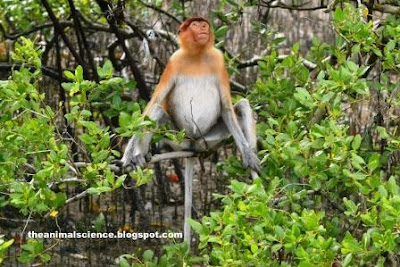 |
| A female proboscis monkey sitting on the tree branch. Photo by: Hanifridzuan |
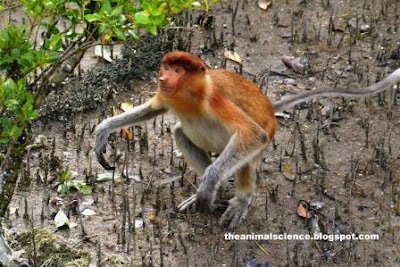 |
| A female proboscis monkey. Photo by: Hanifridzuan |
In Sarawak, Malaysia, this species can be found in Bako National Park (one of the smallest and the oldest national park in Malaysia, gazetted as protected area on 1957). There are seven types of forest in Bako National Park (beach, cliff, kerangas, mangrove, mixed dipterocarp, grassland and peat swamp).
What is the conservation status of Proboscis monkey? It is listed as endangered species in IUCN 2010 and listed in CITES Apendix I. Source: Meijaard, E., Nijman, V. & Supriatna, J. 2008. Nasalis larvatus. In: IUCN 2010. IUCN Red List of Threatened Species. Version 2010.4. <www.iucnredlist.org>. Downloaded on 02 May 2011.
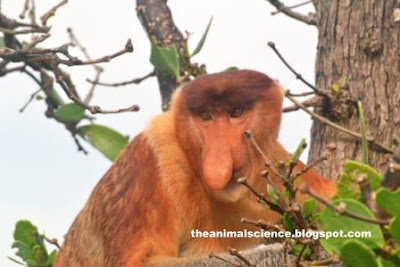 |
| Male Proboscis monkey with a large protruding nose. Photo by: Isham Azhar |
 |
| Random view at Bako National Park. Photo by: Isham Azhar |
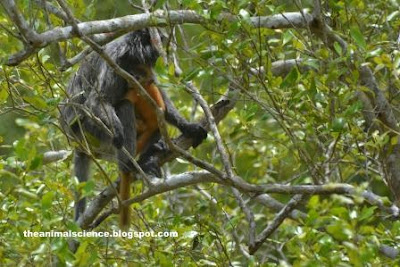 |
| A female silver leaf monkey with the adorable baby clinging to its body. Photo by: Hanifridzuan. |
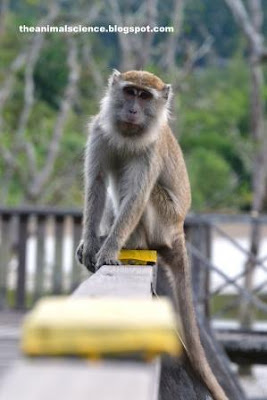 |
| The naughty long tailed macaque. Photo by: Hanifridzuan |
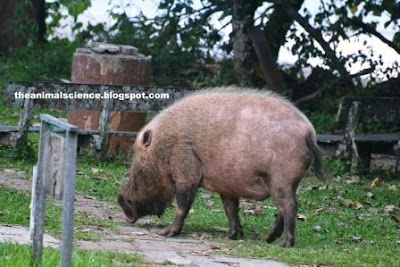 |
| Bearded pig, the largest mammal in Bako National Park. Photo by: Hanifridzuan |
Bearded pig (Sus barbatus) listed as vulnerable in the IUCN and the population trend of this species is also decreasing. Source: Kawanishi, K., Gumal, M. & Oliver, W. 2008. Sus barbatus. In: IUCN 2010. IUCN Red List of Threatened Species. Version 2010.4. <www.iucnredlist.org>. Downloaded on 02 May 2011. In Bako National Park, visitors can easily found this unique animals walking around the park HQ.
Subscribe to:
Comments (Atom)











